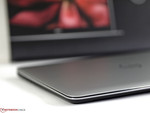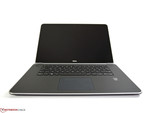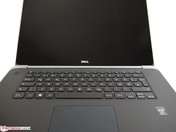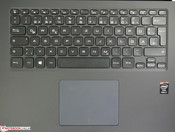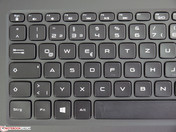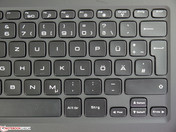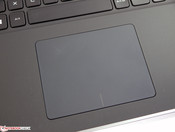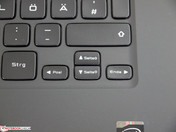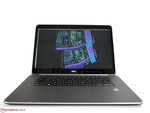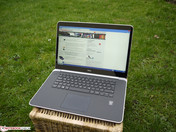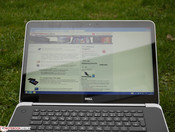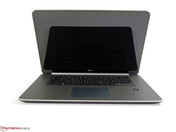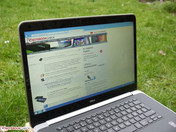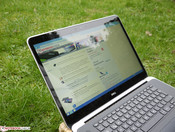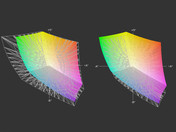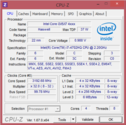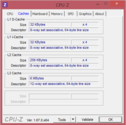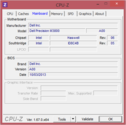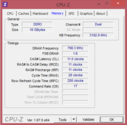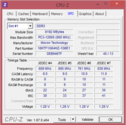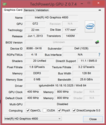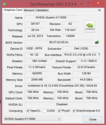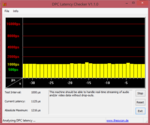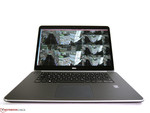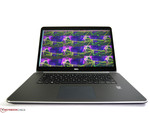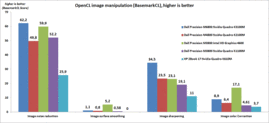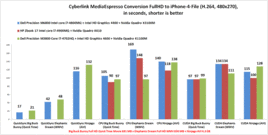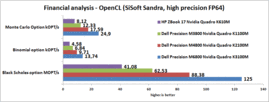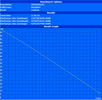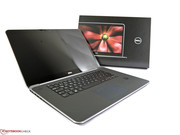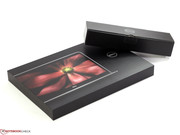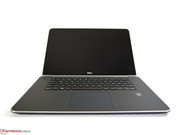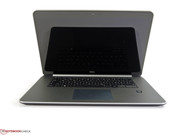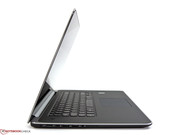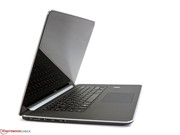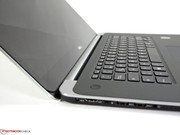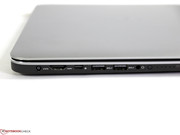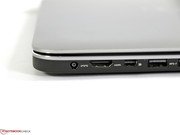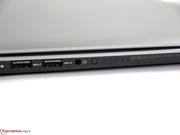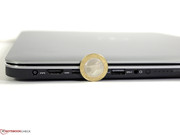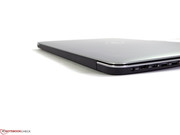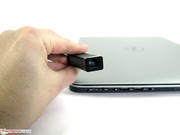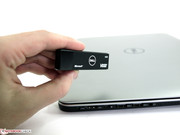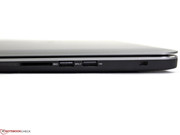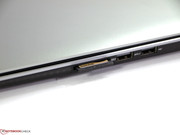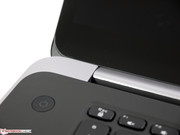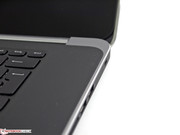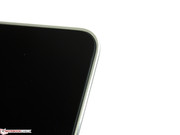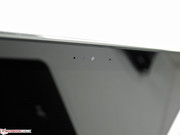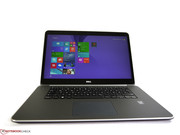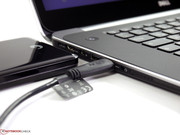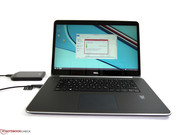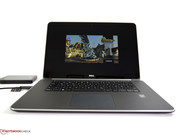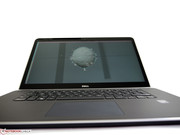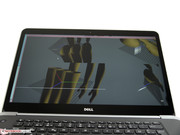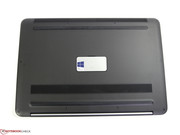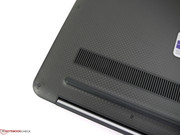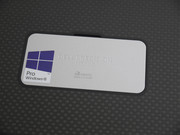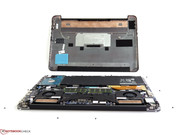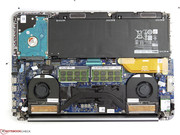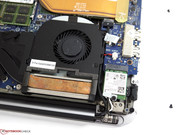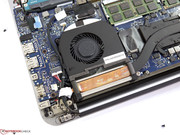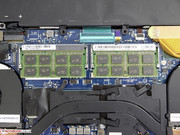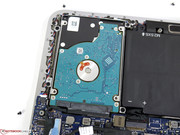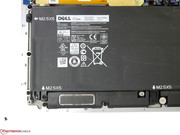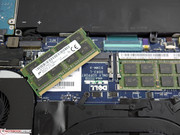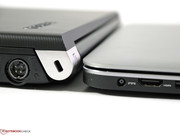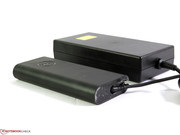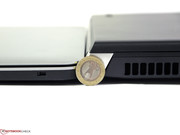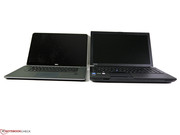Review Dell Precision M3800 Workstation

For the original German review, see here.
Slim, good-looking ultrabooks have not only secured themselves a place on the wish list of private customers, but also on that of business users and professionals. Especially for representative purposes, these devices are much better suited than their rather chunky standard-issue business laptops. Lenovo's ThinkPad S440 and Dell's Latitude E7440 are typical examples of such business-orientated ultrabooks. Still, the Dell Precision M3800 takes this one step further, aiming at the market of powerful workstations. Luckily, no serious cuts seem to have been necessary, as the slim Precision M3800 comes with a quad-core CPU, Nvidia's Quadro K1100M GPU, a high-resolution QHD+ display and a decent selection of ports. Net pricing starts at 1400 Euros (~$1912) and quickly reaches more than 2000 Euros (~$2730).
Our test device comes close to the high-end variant of the M3800, offering an Intel Core i7-4702HQ, an Nvidia Quadro K1100M (Optimus with Intel HD Graphics 4600), 16 GB of RAM, a 256 GB SSD plus a 500 GB HDD, the QHD+ display and Windows 8.1 Pro 64-bit. An identical Precision M3800 model available in Dell's online store costs 1800 Euros (~$2459) (gross price: 2140 Euros; ~$2923), and will supposedly ship on March 3rd, 2014.
Case
The outer appearance of the device profits from the premium materials being used as well as from the extremely slim form factor. At first glance, it appears unlikely that powerful workstation components have been fitted into this ultrabook-like chassis with its height of just 20 millimeters (~0.8 inches, including the rubber feet) and a weight of no more than 2 kg (~4.4 pounds). Metal, glass, plastic and a rubberized surface around the keyboard have been used, working well together. The build quality is superb, further corroborating the high-end ambitions of the device. Small, even clearances are a welcome sight. The laptop does not creak (or emit other unpleasant noises). The palm rest as well as the keyboard deck do not wobble, and the same holds true for the hinges and the display lid (which is also rather torsion-resistant) as well. Unfortunately, the maximum opening angle of the display is too limited, which can be an issue during some usage scenarios. There is some warm air venting in between the display hinges and the chassis, and while we are no fans of this design choice, we did not notice any problems with it, even during continuous stress tests.
Connectivity
The variety of ports being employed by the Dell Precision M3800 cannot compete with most standard-sized workstations, but compared with ultrabooks, it offers quite a lot. HDMI and a Mini Display port are there for external monitors, but unfortunately, they are located too close to each other to use concurrently if you need to use adapters. This also holds true for the four USB ports, all of them including charging functionality, three of them USB 3.0. We are fond of Dell's design decision to place the ports close to the rear end of the device, being less in the way when working with cables and adapters. The only unfortunate exception is the card reader, as memory cards protrude (by approximately 3 millimeters) which is not ideal when carrying the laptop around. The Precision M3800 comes without an ExpressCard slot or a proprietary docking port. This is especially aggravating since our test device already carries fewer ports than other workstations. At least, universal dock solutions can be connected via USB 3.0.
Communication
While the Dell Precision M3800 ships without a regular Ethernet port, Dell includes an external USB-to-Ethernet adapter, which can be used instead. An Intel Wireless-AC 7260 module comes with both 2.4 GHz and 5 GHz Wi-Fi connections (with a theoretical total data transfer rate of up to 867 Mbit/s) as well as Bluetooth 4.0. Wi-Fi signal strength was great, and we did not have any issues with lost connections etc. Depending on the distance between the router and the laptop (but with an unobstructed view from one to the other), real-life results of between 3.1 and 5.7 MB/s were measured, but of course, this is not a lab result, being susceptible to walls, other wireless connections, distortions and different routers.
Security
The M3800 ships with neither a fingerprint scanner nor a Smart Card Reader, lacking two essential components of conventional business laptops. Still, at least a Trusted Platform Module and the usual BIOS and system password locks are available, covering the basics.
Accessories
There are no specific accessories made for the Precision M3800, such as a dock with a proprietary connector or a module bay, making it impossible to use accessories compatible with other Precision laptops. Thus, external universal docking solutions via USB 3.0 would have to be employed. The laptop ships with the USB-to-Ethernet adapter and a USB flash drive including the recovery partition.
Maintenance
The bottom panel is connected to the rest of the base unit via ten Torx (T5) screws. It can be removed easily once the screws are loosened, yielding access to the two fans, the RAM module, the mass storage device and further components. Still, in order to avoid voiding the warranty, it may be advisable to consult the manual first in order to find out which components are meant to be user-accessible.
Warranty
While most competitors offer a trustworthy 36 months of warranty, Dell is unusually tight in this regard, shipping the M3800 with an untraditional and decidedly un-premium 12 months, the same as with most simple consumer laptops. This does in no way match the price of more than 2000 Euros (~$2730). A warranty extension to the commonly offered 3 years costs a net amount of 129 Euros (~$176); quickly doubling to 258 Euros (~$352) once Pro Support is included.
Input Devices
Keyboard
The chiclet-style keyboard ships with the standard format, but without a separate number pad. Obviously, this has been the deliberate decision (the space would be there), leading to one advantage, with the touchpad being centered with respect to both the keyboard and the display (which yields a more comfortable position for the hands while moving the cursor, being preferred by a lot of users while working on one's lap). Whether it is a favorable decision depends on the amount of data entry required. The keys come with medium to short travel, a precise pressure point and low noise emissions. The keyboard labels are kept in a bright gray, being lit by the integrated backlighting system whenever necessary. They are always easy to decipher. Most keys are amply sized (and should not be a concern), except for the slim return key and the arrow keys, which are located too close to each other.
Touchpad
The touchpad is rather large, measuring 104 x 80 mm (~4 x 3 inches) and thus offering more than enough space when moving the cursor or issuing large-scale multi-touch commands. The gliding properties as well as its reaction speed are great, leading to a comfortable working experience. The touchpad buttons function well, too, but they are not quite as "comfy" as dedicated buttons. Unfortunately, not only the number pad is missing, but also a TrackPoint (which is there on all larger Precision laptops), a painful cut for all fans of this input method.
Touchscreen
The multi-touch-enabled display is quite a viable alternative to the touchpad. Although we were skeptical at first - especially given that this is a workstation orientated at professional users and the business segment - it offers great potential. Wiping with a finger, scrolling through long lists, zooming in or out and rotating feels like a breeze, working so smoothly that it does not take long to get addicted (or at least used) to having that functionality in reach. The pre-set scaling factor of 150% allows hitting most folders or desktop symbols without too much trouble, despite the high native QHD+ resolution. This is definitely a technology where Dell is feeling at home, providing a comfortable addition to conventional input methods.
While the underlying hardware base of the touch panel is rock-solid, the limited availability of touch-optimized programs is more of an issue, as the majority of Windows programs are adapted to mouse and keyboard controls. If, in addition to that, even the scaling does not work properly (it has become a lot less of an issue with Windows 8.1, with just a few examples becoming evident during our tests), fonts, icons and menu elements become miniaturized, making handling a chore. Some programs, which we are also using for our tests, have been included as screenshots below, illustrating some of the issues that might arise due to the QHD+ resolution.
Display
Dell offers two different displays for the Precision M3800. The cheaper variant comes with a glossy Full HD display and a resolution of 1920x1080 pixels, while our test device ships with a high-resolution QHD+ panel made by LG, touch included. Its 3200x1800 offer a lot of screen real estate if left at its native resolution, but even those with 20/20 vision will have problems adjusting to the tiny symbols. A scaling factor, of say 1.5, helps making font, icons, symbols and windows easier to read. Luckily, this works rather well thanks to Windows 8.1, with just a few stubborn programs yielding less desirable results such as small fullscreen windows in the center of the screen. This is an especially huge concern when talking about games, as those do not always work as intended, or do not work at all with the resolutions we were employing on the internal screen. Generally, there is not enough choice in terms of display resolution for the internal panel, with just a low number of large steps in between being available. Still, we feel that by now (Windows 8.1), the high resolution offers more benefits than it causes issues so that it should not be seen as a general disqualifier due to possible scaling issues any more.
| |||||||||||||||||||||||||
Brightness Distribution: 91 %
Center on Battery: 400 cd/m²
Contrast: 955:1 (Black: 0.42 cd/m²)
ΔE ColorChecker Calman: 8.19 | ∀{0.5-29.43 Ø4.78}
ΔE Greyscale Calman: 8.1 | ∀{0.09-98 Ø5}
73% AdobeRGB 1998 (Argyll 1.6.3 3D)
77.3% AdobeRGB 1998 (Argyll 3D)
99.4% sRGB (Argyll 3D)
75.8% Display P3 (Argyll 3D)
Gamma: 4.23
CCT: 7293 K
All objective test results of the display are great. The maximum display brightness comes to lie between 370 cd/m² and 405 cd/m² (nine-point measurement). The resulting brightness homogeneity of 91% is superb, yielding barely any noticeable brightness differences even on uniform backgrounds. The brightness can be set to one of ten steps starting at 22 cd/m², with step 4 yielding 164 cd/m², which we used for our battery tests. Anything above 150 cd/m² should normally be more than sufficient during indoor use, but the highly reflective display surface requires us to increase the brightness noticeably in order to outshine the reflections. While this works rather well in closed rooms, during outdoor use, a lot more thought has to go into choosing the right place to work.
This is a high-contrast display, exceeding the average laptop screen by far with a contrast ratio of 955:1, leading to dark blacks and vivid colors. 73% of the AdobeRGB color space and 95% of the sRGB color space (actually even >100% in terms of sheer color area, but not quite lying on top of the sRGB color space) is indeed some coverage to write home about. The display seems to have been calibrated with regard to the AdobeRGB color space, yielding supreme color accuracy only when compared to this color space. When comparing to sRGB, reds and magentas deviate noticeably from their ideal values.
Dell's Premier Color tool cannot be used in the case of the Precision M3800 (it had shipped with both the Precision M4700 and the M6700 with their colorful RGB LED displays). As with the Mobile Display Assistant of the HP ZBook 17, this would allow the user to select pre-defined color spaces with just one click. This might also have helped with the grayscale rendition, although its maximum DeltaE 2000 value of 2.5 is still very decent. Barely any deviations at all have been noticed when looking at the gamma curve and the RGB balance.
Overall, the QHD+ display of the Dell Precision M3800 comes with such a great color space coverage that it is hard to properly restrain it, leading to some limitations concerning color accuracy.
The viewing angle stability of the display is close to superb, leading to great readability from all sides. It takes very narrow angles (from the side or from an angle from the top) to develop a yellowish tint and annoyingly strong reflections of objects and light sources, depending on the surroundings.
Performance
The Dell Precision M3800 offers a lot of performance, especially given its slim profile, making it possible to use it for many applications that may be relevant in professional work environments. Most configurations that are available right now are quite similar, always including Intel's Core i7-4702HQ-CPU and Nvidia's Quadro K1100M dedicated GPU. While these core components may not be absolute high end, they are good enough to serve in a true mobile workstation. Variations can be found with respect to the display, the mass storage drive and the amount of RAM. Our test device comes with a QHD+ display, 16 GB of RAM, a 256 GB mSATA SSD and an additional 500 GB HDD.
Processor
Due to its slim profile, the Dell laptop comes with a quad-core CPU - Intel's Core i7-4702HQ - with a much-reduced Thermal Design Power (TDP) of 37 Watts instead of 47 Watts, a relief for the cooling system. The base clock speed of 2200 MHz can be overclocked via Turbo Boost to up to 3200 MHz, each 200 MHz less than that of the ordinary Intel Core i7-4700MQ. Still, the same 6 MB of L3 cache and the same Intel Hyperthreading technology are on board here as well, leading to just a moderate disadvantage in terms of performance when compared to the regular CPU with its TDP of 47 Watts.
When looking at benchmark results, our test device fares approximately 10% worse than Intel's Core i7-4700MQ (Lenovo ThinkPad T440p), yielding e.g. 1.43 points instead of 1.51 points during the Cinebench R11.5 64-bit single threading and 5.33 instead of 5.86 points during the multithreading test. Shortly after the stress phase has begun, the clock speed reduces to its base clock speed of 2.2 GHz, mostly remaining at this level with a few short spikes in between. Luckily, it never decreases below this threshold. During our real-life tests (converting audio and video files), the Intel Core i7-4702HQ comes close to the lower end of comparable workstation CPUs, but still, it is far from being a slow CPU. Generally speaking, this is still one of the high-end laptop CPUs.
While running on battery, no further reductions in terms of clock speed occur, yielding almost similar results (e.g. 5.34 points during the Cinebench R11.5 64-bit multi).
System Performance
The system performance of our test device is very well balanced, revealing no configuration-induced weaknesses. Only an even faster CPU or an even more powerful GPU could further improve the results of the M3800. However, due to the slim chassis and the resulting issue of having to control the heat emissions of the device, no higher-end components are currently available according to Dell's data sheet accompanying the Precision M3800. We have performed all available PC Mark 8 tests. The results: 3322 points (home sequence), 3970 points (creative sequence), 3641 points (work test) and 4912 points (memory test). Together with the 5650 points during PC Mark 7 and the 17946 points PC Mark Vantage yields, it becomes obvious that the Dell Precision M3800 is well-suited for a wide range of tasks.
| PCMark Vantage Result | 17946 points | |
| PCMark 7 Score | 5650 points | |
| PCMark 8 Home Score Accelerated | 3322 points | |
| PCMark 8 Creative Score Accelerated | 3970 points | |
| PCMark 8 Work Score Accelerated | 3641 points | |
Help | ||
Mass Storage
In our test device, Dell combines a 256 GB mSATA SSD (including the system partition) with a conventional 500 GB HDD for data, yielding more than enough storage space for movies, photos and other files and at the same time a fast system drive with read and write speeds of more than 480 MB/s and almost 400 MB/s, respectively (transferring large data files with several hundred MB/s). While this mSATA drive made by Lite may not be an absolute high-end model, its performance boost can easily be felt during daily life. Everything feels zippy, the system boots in 5 to 7 seconds and programs as well as files are opened without any noticeable lag. These strengths are easy to get used to, making it hard to appreciate the few remaining advantages of HDDs.
Graphics Card
The Dell Precision M3800 contains both the integrated Intel HD Graphics 4600 GPU as well as the dedicated Nvidia Quadro K1100M graphics card. Thanks to Nvidia's automatic (and rather reliable, as it has matured for a long time) Optimus technology, the system switches between the integrated GPU (used for less intensive tasks) and Nvidia's Quadro GPU for more demanding 3D applications. Those who do not trust the default settings of Optimus can define which GPU is to be used for which program.
While Intel's HD Graphics 4600 may thus be better suited for MS Office, web browsing and other simple tasks, the core functionality of the Nvidia Quadro K1100M is to be found with professional CAD programs. Optimized drivers, a specialized BIOS and dedicated CAD support lead to a greatly increased performance for all software suites that support certain OpenGL features. The SPECviewperf.11 benchmark uses a number of CAD tools in order to compare different GPUs, with differences that - as we have noted before - can vary greatly depending on the exact combination between GPU, driver and program in question. The Quadro GPUs show their full strength with Catia, Pro/Engineer and Tcvis. For Lightwave, Maya, Solidworks and Siemens NX, last year's AMD FirePro M4000 is still the better choice. Ensight, on the other hand, is the only sequence where powerful consumer graphics cards stand a chance (such as the GTX 780M of the Alienware 17 which takes the top spot of all GPUs here). Otherwise, consumer chips are only truly useable with apps that make use of the DirectX interface, such as AutoCAD 2013 or Autodesk Inventor.
When compared to the Nvidia Quadro K2100M of the Dell Precision M4800, our test device loses the battle, with the difference coming to lie between 6 and 40% (notwithstanding the issue that improved drivers could actually enlarge this gap even further). Worse, the difference between our test device and the entry level Quadro solution, the Quadro K610M, is actually far less than expected, with the benchmark even deciding in favor of the lower-end GPU in two of the tests (Pro/Engineer and Lightwave), despite our test device shipping with the more recent driver versions.
Under full CPU and GPU load, the GPUz tool showed a reduced GPU core clock speed of 567 MHz. During actual usage scenarios such as converting videos via CUDA and simultaneously converting audio files via iTunes (which is not quite as extreme as the stress test), however, no down-clocking could be measured. We are glad to report that the Nvidia Quadro K1100M exhibits no throttling while running on battery, with the results remaining basically on par (44.27 fps instead of 44.30 fps during the Cinebench OpenGL Shading test).
The topic of GPGPU Computing via the open OpenCL interface becomes ever more important, transferring typical CPU-intensive tasks to the GPU in order to lead to a more balanced distribution of tasks and thus faster completion. OpenCL is mostly being used with some image editing filters, video editing software or special tools such as WinZip 17. We are testing the performance of our device with the BasemarkCL benchmark and test sequences from Sisoft Sandra. Extensive light and shade calculations are performed via Raytracing with the help of the Luxmark benchmark.
Next to OpenCL, Nvidia GPUs also come with the homegrown CUDA engine, the performance of which we are testing with the video conversion tool MediaEspresso - comparing it to the highly efficient Quick Sync Video alternative made by Intel.
Despite its focus on professional applications, the Nvidia Quadro K1100M is unable to truly shine in any of these tests. Even the integrated Intel GPU fares better at times, sometimes noticeably so. The Luxmark result of the AMD FirePro M4000 from the previous year shows the potential of more recent AMD FirePro GPUs as it beats even the high-end Nvidia Quadro K3100M from the Dell Precision M6800 by a great margin.
| LuxMark v2.0 64Bit | |
| Room GPUs-only (sort by value) | |
| Dell Precision M3800 QHD+ Display | |
| HP EliteBook 8570w LY550EA-ABD | |
| Dell Precision M6800 | |
| Lenovo ThinkPad S440 | |
| Dell XPS 12 Haswell | |
| Sala GPUs-only (sort by value) | |
| Dell Precision M3800 QHD+ Display | |
| HP EliteBook 8570w LY550EA-ABD | |
| Dell Precision M6800 | |
| Lenovo ThinkPad S440 | |
| Dell XPS 12 Haswell | |
Despite the drivers being optimized for OpenGL, no performance drops are to be expected when using DirectX-based software. The hardware of the Nvidia Quadro K1100M actually comes very close to that of an Nvidia GeForce GT 730M with a 128-bit memory interface and 2 GB of GDDR5 memory - the only slight difference being the (dynamical) clock speeds of the Quadro up to 705 MHz. Accordingly, both GPUs are approximately on par, yielding 8992 points during 3D Mark Vantage, 2035 points during 3D Mark 11, 7640 points during 3D Mark Cloud Gate and 17.5 fps during the Unigine Heaven 3.0 DX11 test. Other than with OpenGL software, no optimized special features can be implemented via drivers when the DirectX interface is being used - making the raw hardware prowess the only thing that counts.
| 3DMark 06 Standard Score | 11921 points | |
| 3DMark Vantage P Result | 8992 points | |
| 3DMark 11 Performance | 2035 points | |
| 3DMark Ice Storm Standard Score | 55002 points | |
| 3DMark Cloud Gate Standard Score | 7640 points | |
| 3DMark Fire Strike Score | 1301 points | |
Help | ||
Gaming Performance
While a mobile workstation will likely only be used for serious work applications and not for games, the differences between a private computer and the work device are not as clear as they used to be - as can actually be seen with the sleek design of the Dell Precision M3800, following the desire for a slimmer and more premium-looking laptop. We have used this rare opportunity to take the Nvidia Quadro K1100M for a spin, trying to gauge its gaming performance.
The only thoroughly non-playable title we tested was Company of Heroes 2, with just 25 fps even on minimum settings. All other games worked smoothly, most of them even with everything set to "high". Unfortunately, there is a limitation: The popular resolution of 1366x768 pixels is only accessible on an external display, requiring games to switch to 1280x720 pixels instead (which we have not done, in order to render the resulting frame rates comparable to all other values in our data bank). Additional issues arise due to the native QHD+ resolution, at least when scaling issues occur, leading to either extremely small windows, symbols and fonts or a misalignment between the graphical representation and the actual click areas, not recognizing clicks correctly.
| low | med. | high | ultra | |
|---|---|---|---|---|
| World of Warcraft (2005) | 342 | 212 | 54 | 21 |
| Half Life 2 - Lost Coast Benchmark (2005) | 252.4 | |||
| Sims 3 (2009) | 578 | 295 | 187 | |
| StarCraft 2 (2010) | 223 | 71 | 48 | 26 |
| Total War: Shogun 2 (2011) | 184.4 | 39.29 | 15.3 | |
| Deus Ex Human Revolution (2011) | 138 | 62 | 23 | |
| Batman: Arkham City (2011) | 53 | 47 | 35 | 20 |
| Anno 2070 (2011) | 81 | 39 | 26 | 13 |
| Alan Wake (2012) | 47 | 28 | 11 | |
| Diablo III (2012) | 108 | 74 | 78 | 42 |
| Dirt Showdown (2012) | 97 | 78 | 49 | 15 |
| Sleeping Dogs (2012) | 73.7 | 58.5 | 31.4 | 7.5 |
| Torchlight 2 (2012) | 129 | 91 | 80 | |
| F1 2012 (2012) | 136 | 110 | 93 | 41 |
| Borderlands 2 (2012) | 62 | 52 | 36 | |
| World of Tanks v8 (2012) | 112 | 56 | 42 | 17 |
| Hitman: Absolution (2012) | 52.4 | 37.9 | 24.2 | 14.3 |
| Assassin´s Creed III (2012) | 52 | 43 | 12 | |
| Far Cry 3 (2012) | 58 | 42 | 26 | 7 |
| Tomb Raider (2013) | 103 | 56.3 | 39.1 | 13.6 |
| BioShock Infinite (2013) | 87.4 | 44.5 | 42.4 | 15.4 |
| Metro: Last Light (2013) | 44.9 | 33.9 | 24.8 | 12 |
| GRID 2 (2013) | 145.4 | 74.6 | 54.3 | 16.6 |
| Company of Heroes 2 (2013) | 24.5 | 19.1 | 10.1 | 4.1 |
| Saints Row IV (2013) | 75 | 61 | 26 | 15 |
| Total War: Rome II (2013) | 83.8 | 62.5 | 49.1 | 7 |
Emissions
System Noise
Despite its ultrabook form factor and its powerful innards, our test device offers rather low noise emissions. Since many of our readers have been complaining about high-frequency high pitch noises, especially with slim laptops, we have listened especially closely to the Precision M3800 - and we could not hear any annoying noises, no humming, no buzzing, just "conventional" fan noises.
The HDD is rather quiet as well, its motor sounding a lot like a slowly rotating fan. The sound is not too unpleasant in terms of the frequencies generated. The noise emissions, as measured, reached 29.9 dB(A) at a distance of 15 cm (~5.9 inches) from the base unit - something which could be reduced further (or even removed altogether while idle) if only an SSD was to be used. Naturally, under medium load (3D Mark' 06), the cooling system spins up, reaching 37.8 dB(A). While this will not prove to be annoying except for the most sensitive users, the 43.2 dB(A) under full load (with the fans reaching their maximum rotation speed) will likely become unpleasant if encountered for prolonged periods. Still, this is a rather typical behavior for a mobile workstation, being one of the limitations necessitated by the platform.
Noise level
| Idle |
| 29.9 / 29.9 / 29.9 dB(A) |
| HDD |
| 29.9 dB(A) |
| Load |
| 37.8 / 43.2 dB(A) |
 | ||
30 dB silent 40 dB(A) audible 50 dB(A) loud |
||
min: | ||
Temperature
The two fan vents are not only responsible for the quiet system noise, but also for highly efficient heat dissipation. With up to just 44.1 degrees Celsius (111.38 degrees Fahrenheit) under continuous full load (measured near the rear end of the keyboard), the M3800 remains comfortably cool at all times. Even the large amount of hot air rising between the base unit and the display has not led to problems - yielding no more than 42.5 degrees (108.5 Fahrenheit) in this area.
(±) The maximum temperature on the upper side is 44.1 °C / 111 F, compared to the average of 38.2 °C / 101 F, ranging from 22.2 to 69.8 °C for the class Workstation.
(+) The bottom heats up to a maximum of 37.7 °C / 100 F, compared to the average of 41.2 °C / 106 F
(+) In idle usage, the average temperature for the upper side is 30.2 °C / 86 F, compared to the device average of 32 °C / 90 F.
(+) The palmrests and touchpad are cooler than skin temperature with a maximum of 28.5 °C / 83.3 F and are therefore cool to the touch.
(±) The average temperature of the palmrest area of similar devices was 27.9 °C / 82.2 F (-0.6 °C / -1.1 F).
Speakers
The speakers of the Dell Precision M3800 do not lead to a satisfying audio experience, with over-emphasized highs and far weaker mids and bass. External solutions can be connected via the 3.5mm audio jack (important to note: A combined Line In/Out port) or USB, leading to a noticeable improvement in terms of sound quality.
Energy Management
Power Consumption
The minimum power consumption of 11.3 Watts is more or less on the decent side, probably due to the Intel HD Graphics 4600 kicking in during less demanding tasks. Then again, the minimum display brightness of just 22 cd/m² is extremely low, with all wireless modems being turned off. During actual usage (MS Office, activated wireless modems, medium display brightness), 18 to 20 Watts can be expected. Under medium system load (with the Nvidia Quadro GPU being active), up to 70 Watts are drawn, with this value increasing to up to 87.6 Watts (and a long-term constant plateau of 82.2 Watts) under full load.
| Off / Standby | |
| Idle | |
| Load |
|
Key:
min: | |
Battery Life
The battery within the chassis (fastened with a number of screws) comes with a capacity of 61 Wh, which is pretty much the standard capacity for 15-inch laptops. Together with decent power consumption levels, a solid foundation for useable battery runtimes has been established. In addition, the Dell Precision M3800 can even be had with a 91 Wh battery if the 2.5-inch mass storage device is removed.
The Battery Eater Reader's Test (minimum display brightness, airplane mode, energy-saving mode) yields 6:25 hours of battery life while the more lifelike Wi-Fi test (energy-saving mode, wireless activated, display brightness set to 164 cd/m²) results in almost 3 hours of uptime with the Nvidia GPU and 3:29 hours with the integrated Intel solution. The Full HD video playback test with a looped version of "Big Buck Bunny", loaded from the hard drive (Intel Graphics, energy-saving mode, airplane mode, display brightness of 164 cd/m²), ends after 3:38 hours. Even the 0:59 hours during the Battery Eater Classic Test (maximum display brightness, high-performance profile, Nvidia GPU, wireless modems activated) are still an okay result. Overall, the Dell Precision M3800 offers still-decent battery life despite its slim chassis and its good performance levels, leading to a useful in-between compromise for many users.
Verdict
The Dell Precision M3800 combines the best of the core functionality of two quite different worlds. The powerful components of a mobile workstation are mixed with the slim chassis of an ultrabook - quite the feat, which, surprisingly, comes without many major disadvantages. The few that there are will have to be taken into account, though.
The variety of ports is quite good for an ultrabook, but not truly on par with most other mobile workstations as some core features such as a proprietary docking port, a module bay, different battery options or traditional security features are missing. Then again, the components that do exist are easy to reach, being structured cleanly. Most essential components can be replaced, something which is not the case with most other ultrabooks.
The average battery runtimes and the hard performance limits due to the slim design are necessary evils given the form factor, but the performance is still decent enough for most professional usage scenarios and should prove to be sufficient for most potential customers.
Much more painful: The Dell Precision M3800 is Dell's first mobile workstation in years that comes with a standard warranty of just 12 months, instead of 36. This is just a policy issue, but annoying nonetheless, unworthy of such a premium device.
Still, the great, though highly reflective QHD+ display with its superb touch panel, the good CAD performance of the machine, low noise emissions (in most cases) as well as low surface temperatures, a number of warranty of service options and the sturdy chassis are huge points in its favor.
In the end, the personal needs and expectations of the potential customer are going to be the decisive factor. Apart from that, the Dell Precision M3800 comes with an attractive, unique selling point, being a magnificent - and unique - example of a successful symbiosis between a workstation and an ultrabook.




